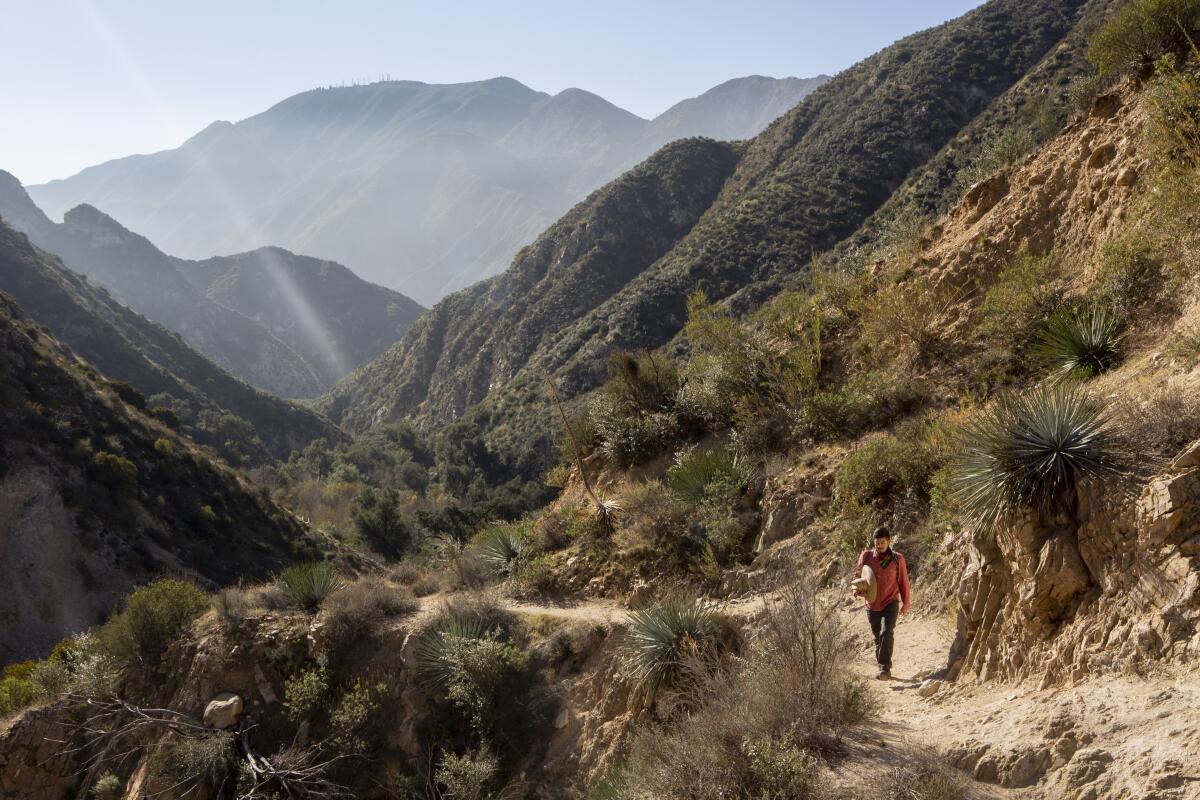They live in L.A. County’s riskiest areas. Should they rebuild on their burned-out lots?

- Share via
They were drawn to the Altadena foothills for the hummingbirds and the bats and the peacocks. It was the view of the canyon, downtown skyscrapers, and Santa Catalina Island, somehow all in one frame.
Everyone on Leilani Way knew the risks of living in the San Gabriel Mountains’ fire-prone foothills. The benefits just outweighed them.
“That ability of being near the wildlands wasn’t just a scary threat,” said Erik Ghenoiu, who treasured daily dog walks on the trails. “It was part of what we all loved about it.”
But residents say the last week has served as a brutal reminder of the stakes as they watched flames leap out of the foothills and leave their oak-tree dotted refuge looking like a moonscape. Ghenoiu’s home is gone. So are most of his neighbors’.
As thousands of reeling homeowners weigh rebuilding, residents of the tight-knit street are forced to confront an even more fraught question — not just should they rebuild, but should they do it in an area likely to burn again.
“We’re obviously torn. ... Part of you wants to do it right away. And part of you is hesitant to even think about rebuilding in the same place,” Ghenoiu said. “Should we build in these sites at all?
For years, L.A. County officials have been trying to deter people from doing just that. One month before fire tore through Altadena, the planning agency notched a victory with the passage of a zoning update years in the making. It barred more homes in unincorporated swaths of west San Gabriel Valley, which the state has designated a “Very High Fire Hazard Severity Zone.”
That includes the foothills of Altadena, where at least two people have died in the Eaton Fire, according to addresses provided by the coroner.

Amy Bodek, who leads the county’s planning department, said the plan won’t have an effect on homeowners who are simply looking to rebuild their homes — rather than add additional ones — in these vulnerable areas.
“We absolutely support individuals’ rights to rebuild and are here to do everything that we can to help them,” she said.
At the same time, though, the county has taken a clear stance: It doesn’t want more people living in the foothills.
“It’s a legitimate conundrum,” Bodek said.
It’s one the county will be grappling with for the foreseeable future: How do you balance the need to rapidly rebuild while deterring homes in areas likely to burn again?
“The fire crisis in California is inseparable from the housing crisis,” said Robert Olshansky, an expert in post-disaster planning and relocation. “There really aren’t a lot of attractive options for where else they can go.”

Ghenoiu, an architectural historian, said he believes there’s a way to rebuild smarter. Covered windows, hardscape, and fire-resistant vents and siding are all high on his wish list.
His neighbors are hoping for the same. They just don’t know whether the insurance payments will be enough to make those improvements a reality.
“It’s going to be so expensive being in California and doing it right,” said Taylor Zann, a content designer who built his own home. “Our payout is not going to cover it, so I just don’t know what we’re going to do.”
Leilani Way was a sanctuary for its residents, a dead-end offshoot from Chaney Trail so discrete that Uber drivers had difficulty finding it. It is now mangled beyond recognition.
Zann’s home, the product of four years labor that he says left him familiar with the location of every stud, is reduced to rubble, the mid-century vaulted ceiling gone and the metal roof crumpled on the ground. Most of his neighbor’s lots are home to similar piles of ash and twisted metal.
Farther down the block, Michael Bicay owns one of the few homes that survived, a succulent-covered house from 1949. He suspects the survival is some combination of luck and updates he made to his house after a close call during the 2009 Station fire.
Bicay, an astrophysicist and head of conservationist group AltadenaWild, doesn’t think more people in fire-prone foothills makes any sense. The fire that just decimated his street, he says, made that “abundantly” clear.
That said, he thinks telling a homeowner they shouldn’t rebuild is unrealistic. He’s not even sure what he would do had his home turned to rubble.
“I just don’t think society is ready to ban development in these areas,” he said. “All we can do is stop new developments from happening.”
It’s not like the embers strictly adhered to the state’s map, Bicay said. Some of the 2,200 houses in the hazardous zone survived, he noted. And many of the homes outside the zone did not.

L.A. County Supervisor Kathryn Barger, who represents the unincorporated town, has been adamant that the whole of Altadena comes back. At a board meeting this week, she cut off the county assessor as he discussed property taxes for residents “if you rebuild.”
“When they rebuild,” she interjected. “I’m saying when.”
Karen Chapple, a city planning expert at UC Berkeley, said that’s usually the message in the aftermath of a disaster.
“Politically, you’d never say, ‘Go away’,” she said. “The politics of that are horrific.”
But she said there’s a deeper conversation that must happen on the state level as residents rush to rebuild, in some cases, adding “literally fuel to the next fire.”
“From a policy perspective, or from a California taxpayer perspective, should we be subsidizing people to go back to these places where we’re going to have to bail them out again?” she said. “That is a real question that I think the good residents of California have to face.”

Since the 2018 Woolsey fire blackened tens of thousands of acres north of Malibu, some conservationists say L.A. County has emerged as a leader in planning for a fire-heavy future, trying to rein in the sprawl for which the region is famous.
Dan Silver, head of Endangered Habitats League, said the county has been locating homes that the state mandates be built away from the mountains, while making it more difficult for residents who “spread out, sprawl and leapfrog into dangerous locations.”
“It’s been really, quite a planning achievement,” said Silver, noting a recent crackdown on subdivisions in fire-prone areas. “L.A. County is really the model now.
“There’s plenty to disparage, for sure — the land use of the past 100 years.” But the county, he said, has “put their money where their mouth is.”
One area where Bodek says the county hasn’t been able to have much effect: the locations of accessory dwelling units, or ADUs.
Bodek says the county tried to ban ADUs in risky areas because “adding additional population to the fire zones was something that the county was not interested in doing.” She said it was trumped by the state.
The state said its fire designations “are not intended to restrict housing development” and a high hazard zone “is not a conclusive rationale to warrant restricting ADUs,” according to state guidelines. David Zisser of the state Department of Housing and Community Development said in a statement that ADUs can be restricted in these areas in certain circumstances.
“I wanted to start saying no,” Bodek said of the blanket ban. “The state said, ‘No, you can’t do that.’”
Grace Lee-Bloch and her husband, Justin, had an ADU behind their house on Leilani Way. It’s now gone, along with her home. All that remains are the wrought iron front doors.
Lee-Bloch, a teacher, said she worries that people will read about her community and compare it to homeowners who snatch up coastal property doomed to soon be gobbled up by the ocean.
But the natural beauty of Leilani Way — a street with so many hummingbirds she kept having to buy larger feeders— is simply worth the risk. If she can afford it, she said, rebuilding is not a question.
“We’re pretty determined to build a property that could survive something like this,” she said. “We just want our little community back.”
More to Read
Sign up for Essential California
The most important California stories and recommendations in your inbox every morning.
You may occasionally receive promotional content from the Los Angeles Times.










